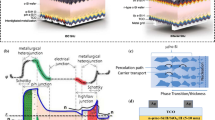Abstract
In order to promote the widespread utilization of photovoltaic structures it is critical to increase their conversion efficiency and reduce their manufacturing cost. With these two goals in mind, planar and nanotexturized c-Si photovoltaic devices were built and their radiation incident side was covered with CdTe quantum dots (QDs) dispersed in a poly-methyl-methacrylate thin film ~100 nm thick. The measured performance with and without the CdTe QD layer indicates that the down-shifting photoluminescence (DSPL) of the synthesized QDs triggers an increase in the open circuit voltage and the short circuit current, resulting in an overall improvement of ~1.5 % in the power conversion efficiency of the produced devices. This observation can be understood as a result of decreasing the number of high energy photons that are prone to unproductive near surface absorption in c-Si p-n junction solar cells and the re-emission of lower energy photons that are more effectively bulk-absorbed in c-Si solar cells. The result of lowering the near surface photon absorption represents a reduction of carrier losses due to the high surface recombination velocity as well as the low lifetime that normally plague the diffused side of an active junction device. Additionally, solar cells with a layer of CdTe QDs exhibit a higher external quantum efficiency when compared to devices without the aforementioned quantum dots. Layers of CdTe QDs are economically attractive, highly photostable and their absorption and emission spectra have a strong dependence on particle size, therefore, they lend themselves to providing a broad DSPL spectrum and promoting the proliferation of photovoltaic structures.









Similar content being viewed by others
References
Air Mass1.5 Spectra (2015) http://rredc.nrel.gov/solar/spectra/am1.5/S.
Cademartiri L, Bertolotti J, Sapienza R, Wiersma DS, von Freymann G, Ozin GA (2006) Multigram scale, solventless, and diffusion-controlled route to highly monodisperse PbS nanocrystals. J Phys Chem B 110:671–673
Chartier C, Bastide S, Lévy-Clément C (2008) Metal-assisted chemical etching of silicon in HF–H2 O2. Electrochim Acta 53:5509–5516
Chen O, Zhao J, Chauhan VP, Cui J, Wong C, Harris DK et al (2013) Compact high-quality CdSe–CdS core–shell nanocrystals with narrow emission linewidths and suppressed blinking. Nat Mater 12:445–451
Dingemans G, Kessels W (2012) Status and prospects of Al2O3-based surface passivation schemes for silicon solar cells. J Vac Sci Technol A 30:040802
Gordillo H, Suárez I, Abargues R, Rodríguez-Cantó P, Albert S, Martínez-Pastor J (2012) Polymer/QDs nanocomposites for waveguiding applications. J Nanomater 2012:33
Greytak AB, Allen PM, Liu W, Zhao J, Young ER, Popović Z et al (2012) Alternating layer addition approach to CdSe/CdS core/shell quantum dots with near-unity quantum yield and high on-time fractions. Chem Sci 3:2028–2034
Hirst LC, Ekins-Daukes NJ (2011) Fundamental losses in solar cells. Prog Photovolt Res Appl 19:286–293
Kalytchuk S, Gupta S, Zhovtiuk O, Vaneski A, Kershaw SV, Fu H et al. (2014) Semiconductor nanocrystals as luminescent down-shifting layers to enhance the efficiency of thin-film CdTe/CdS and crystalline Si solar cells. J Phys Chem C 118(30):16393–16400
Li X (2012) Metal assisted chemical etching for high aspect ratio nanostructures: a review of characteristics and applications in photovoltaics. Curr Opin Solid State Mater Sci 16:71–81
Li JJ, Wang YA, Guo W, Keay JC, Mishima TD, Johnson MB et al (2003) Large-scale synthesis of nearly monodisperse CdSe/CdS core/shell nanocrystals using air-stable reagents via successive ion layer adsorption and reaction. J Am Chem Soc 125:12567–12575
Moreels I, Justo Y, De Geyter B, Haustraete K, Martins JC, Hens Z (2011) Size-tunable, bright, and stable PbS quantum dots: a surface chemistry study. ACS Nano 5:2004–2012
Pudasaini PR, Elam D, Ayon AA (2013a) Aluminum oxide passivated radial junction sub-micrometre pillar array textured silicon solar cells. J Phys D Appl Phys 46:235104
Pudasaini PR, Ruiz-Zepeda F, Sharma M, Elam D, Ponce A, Ayon AA (2013b) High efficiency hybrid silicon nanopillar-polymer solar cells. ACS Appl Mater Interfaces 5:9620–9627
Pudasaini PR, Sharma M, Ruiz-Zepeda F, Ayon AA (2014) Efficiency improvement of a nanostructured polymer solar cell employing atomic layer deposited Al2O3 as a passivation layer. Microelectron Eng 119:6–10
Semaltianos N (2007) Spin-coated PMMA films. Microelectron J 38:754–761
Shockley W, Queisser HJ (1961) Detailed balance limit of efficiency of p-n junction solar cells. J Appl Phys 32:510–519
Suárez I, Gordillo H, Abargues R, Albert S, Martínez-Pastor J (2011) Photoluminescence waveguiding in CdSe and CdTe QDs–PMMA nanocomposite films. Nanotechnology 22:435202
Swayambunathan V, Hayes D, Schmidt KH, Liao Y, Meisel D (1990) Thiol surface complexation on growing cadmium sulfide clusters. J Am Chem Soc 112:3831–3837
Wu X, Liu H, Liu J, Haley KN, Treadway JA, Larson JP et al (2002) Immunofluorescent labeling of cancer marker Her2 and other cellular targets with semiconductor quantum dots. Nat Biotechnol 21:41–46
Wu S, Dou J, Zhang J, Zhang S (2012) A simple and economical one-pot method to synthesize high-quality water soluble CdTe QDs. J Mater Chem 22:14573–14578
Acknowledgments
We thank the U.S. Army Research Office, for the financial support provided for this project (ARO Grant Number W911NF-13-1-0110), and CONACYT for the fellowship awarded to Ulises Tronco.
Author information
Authors and Affiliations
Corresponding author
Rights and permissions
About this article
Cite this article
Tronco-Jurado, U., Saucedo-Flores, E., Ruelas, R. et al. Synergistic effects of nanotexturization and down shifting CdTe quantum dots in solar cell performance. Microsyst Technol 23, 3945–3953 (2017). https://doi.org/10.1007/s00542-015-2748-4
Received:
Accepted:
Published:
Issue Date:
DOI: https://doi.org/10.1007/s00542-015-2748-4




